THE MARKET REPORT


Where work and culture meet what’s possible.
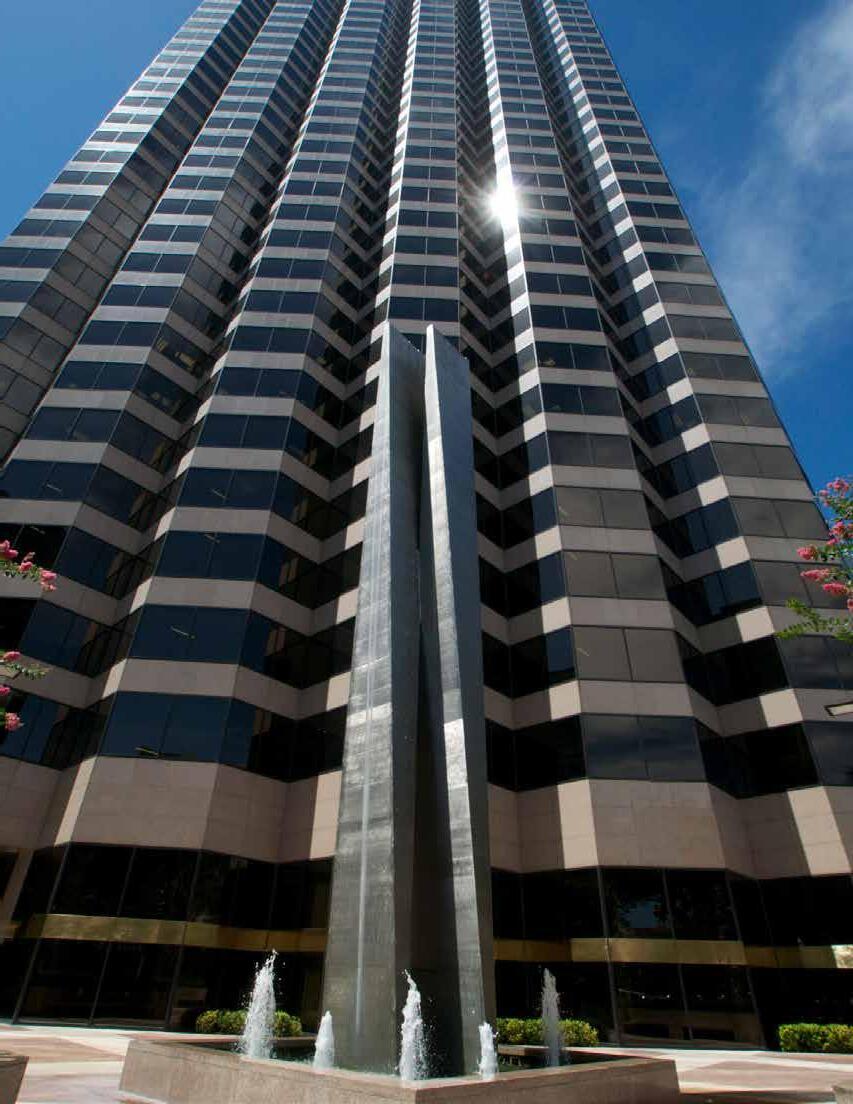
Seth Knudsen PRESIDENT & CEO
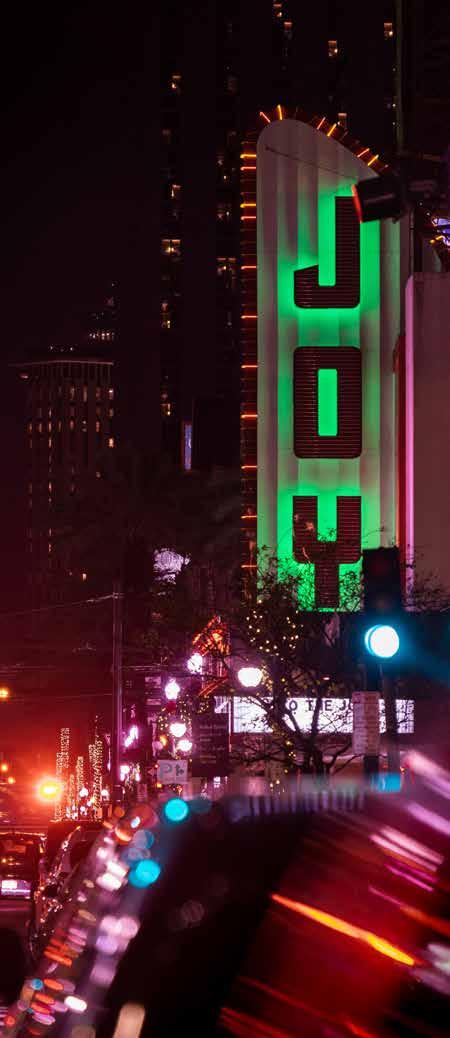




Seth Knudsen PRESIDENT & CEO

Charles Bourg
CHIEF OF PUBLIC SAFETY & FIELD OPERATIONS
Dr. Michael J. McKnight, Sr. CHIEF FINANCIAL OFFICER
Ren é Pastorek, AICP
CHIEF ECONOMIC DEVELOPMENT OFFICER
Jared Brossett
DIRECTOR OF PUBLIC POLICY & EXTERNAL AFFAIRS
Donald G. Clouse
PUBLIC SAFETY MANAGER
John Roussell
PUBLIC SPACE OPERATIONS MANAGER
Brandon Smith
QUALITY ASSURANCE MANAGER
Tyler Correa
ECONOMIC DEVELOPMENT SPECIALIST
Dajuantae Riggins
STAFF ACCOUNTANT
Tempestt Woods
ADMINISTRATIVE COORDINATOR
Francia Barradas
CHIEF OF STAFF TO THE PRESIDENT & CEO
Chris R. Ross NAI RAMPART | CHAIR
Alex Glaser JONES WALKER | VICE-CHAIR
William Bradshaw II REIMAGINE DEVELOPMENT PARTNERS | TREASURER
Ryan King DELTA UTILITIES | SECRETARY
COMMISSIONERS
Gregory Curtis WINDSOR COURT HOTEL
Edwin Murray LSU HEALTH NEW ORLEANS
David Piscola HILTON NEW ORLEANS
Scott Polakoff RESIDENT
Kenny Rubenstein RUBENSTEINS
Miles Tully, Jr. CAESARS NEW ORLEANS
Frank Zumbo NEW ORLEANS MARRIOTT
Dear Downtown stakeholders,
As we reflect on the third quarter of 2025, Downtown New Orleans continues to demonstrate what can be achieved through persistence and partnership. The significant progress reflected in this report is the product of continued strategic investment, both public and private, that supports a cleaner, safer, and stronger Downtown.

Downtown’s momentum continues to build, marked by strong performance and meaningful wins across all sectors. Retail vacancy fell to 6.1 percent as experiential tenants and local entrepreneurs infused new energy into the streetscape. The hospitality sector remained robust, with continued progress on like Audubon’s Riverfront for All project and signature events such as Tales of the Cocktail and NOLA Pickle Fest drawing a steady stream of crowds.
Major institutional investments from Tulane, Xavier-Ochsner, and LSU Health continue to advance the BioDistrict, elevating Downtown as a national leader in research and innovation. Meanwhile, expanded mobility through Amtrak’s Gulf Coast Service, new e-bike initiatives, and workforce parking programs reinforced Downtown’s position as a vibrant, accessible, and future-ready urban center.
As we commemorated nearly 20 years of transformation since Hurricane Katrina this quarter, the data and developments outlined in this report speak to more than just recovery; they represent reinvention. Downtown New Orleans continues to evolve as a dynamic, mixed-use district that integrates history with innovation, and local character with global reach. Looking towards the future, DDD hosted a Downtown Mayoral Forum to provide its constituents with a platform for open, solutions-oriented dialogue about the critical issues shaping our city: public safety, sanitation, business investment, and economic growth. The convening of candidates, business owners, and residents in one shared space reaffirmed Downtown’s role as the economic engine and civic heart of New Orleans.
Thank you for your continued partnership and support. Together, we continue to build a 21st century Downtown.
Seth Knudsen President & CEO
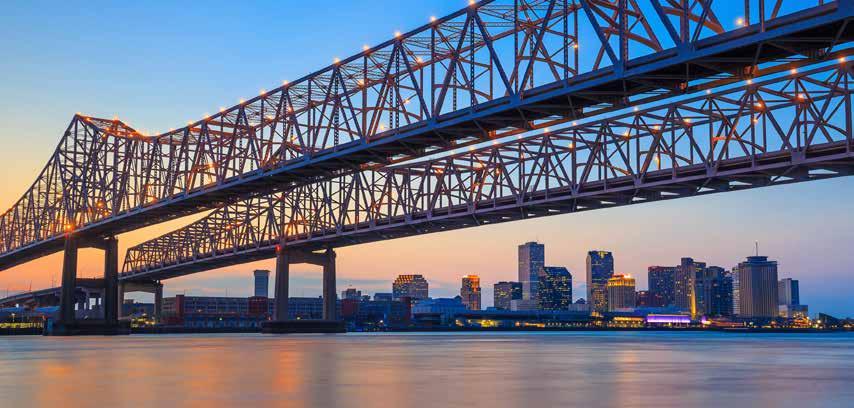
The Downtown Development District of the City of New Orleans (DDD) was created by the Louisiana Legislature in 1974 as the nation’s first assessment-based business improvement district

8.9M Total SF of Class A Office Space
Downtown New Orleans stands as the largest center of employment in the State of Louisiana. Moreover, this collection of neighborhoods represents nearly $1B in assessed property value.
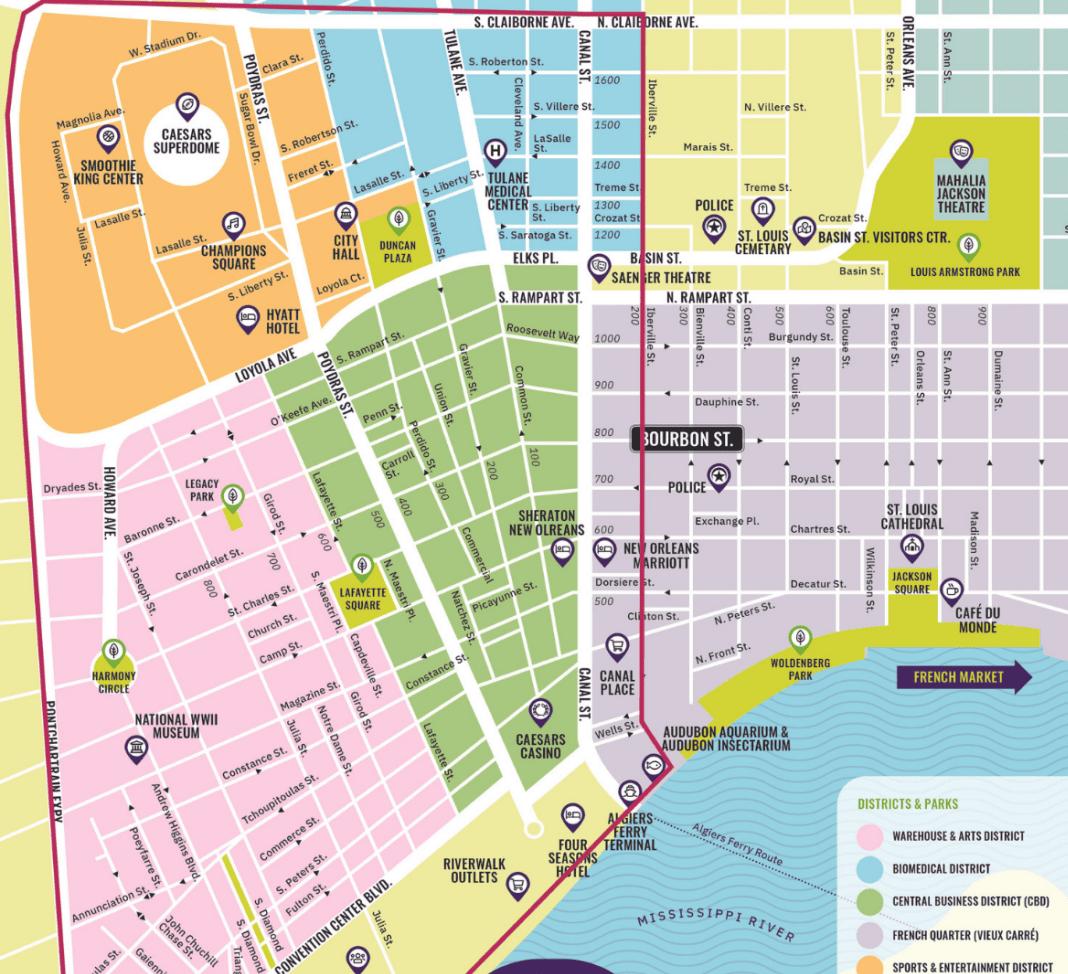
26 Transit Routes
476 Retail Businesses
8 Coworking Spaces and 9 Incubators / Accelerators
98Hotels and 22,680 Rooms
6,370 Condos / Apartments

The Downtown Development District’s third quarter was defined by tangible, visible progress across several quality-of-life and public-realm initiatives. Each project advanced DDD’s long-term mission to make Downtown New Orleans a cleaner, safer, and more economically competitive urban center. This quarter’s accomplishments highlight the value of
sustained incremental investment that compounds over time into noticeable transformation. From landscape enhancements and civic programming to expanded safety initiatives, DDD continues to demonstrate that thoughtful, coordinated improvements can have outsized effects on Downtown’s perception and performance.
Crown Park marked its first anniversary this quarter, representing one of DDD’s most successful examples of catalytic placemaking. Once an underutilized lot at the corner of Girod and Carondelet Streets, the site has evolved into a dynamic community green space that supports lunchtime crowds and passive recreation for neighborhood residents. The park’s activation model—modest in scale but intentional in design—illustrates how strategic use of public space can generate sustained economic and social returns. The activated space has extended activity beyond traditional workday hours, encouraging repeat visitation and strengthening the connection between office, hospitality, and residential users.
Canal Street’s iconic palm trees received a makeover this quarter, as DDD-contracted teams worked to trim and remove fronds and dates from approximately 234 Medjool palms along the central Downtown corridor. The comprehensive effort, spearheaded by the Twin Shores Landscaping & Construction Services, Inc., will help to improve the health, safety, and aesthetic of the trees, ensuring lower
potential for frond and date fall, as well as bolstering palm longevity and overall appearance. Throughout the month of July, the firm completed work along the entire corridor from Claiborne Avenue to Convention Center Boulevard. DDD thanks the team at Twin Shores for their hard work in maintaining the health and beauty of Canal Street’s palms, which stand as a symbol of the historic thoroughfare and our Downtown neighborhood as a whole.
DDD also played a central role in shaping the civic conversation this quarter through its hosting of the Downtown Mayoral Forum. The event convened leading candidates for the city’s top administrative role to discuss Downtown’s most pressing issues, including sanitation, safety, economic growth, and equitable investment. By curating a focused dialogue on these topics, DDD positioned itself as both convener and advocate, ensuring that the city’s economic engine remains a top priority in municipal policy discussions. The forum drew broad attendance from property owners, business owners, and residents, reinforcing DDD’s function as a bridge between the public and
private sectors. The outcome was a spirited discussion that established accountability for future leadership while amplifying Downtown’s voice in the broader civic narrative.
DDD’s existing fleet of public safety bicycles got a serious upgrade this quarter. The public safety team welcomed three new bikes to its inventory, featuring upgraded technology and enhanced abilities to reach more Downtown residents, visitors, and workers than ever before. The new bikes, which feature wide tires, merchandise storage, and effective alert sounds, will support the Public Safety Rangers as they continually work to keep Downtown New Orleans safe through business checks, hospitality checks, homeless outreach engagements, and more.
The DDD team looks forward to widening and strengthening its impact across the District with the introduction of these bikes and extends its gratitude to the City of New Orleans Criminal Justice Commissioner Tenisha T. Stevens and State Senator Jimmy Harris for helping to fund this Downtown improvement.

Nearly two decades after Hurricane Katrina reshaped New Orleans, DDD is proud to recognize the extraordinary transformation of Downtown into a vibrant, mixed-use neighborhood built for the future. What was once a District dominated by office towers and limited after-hours activity is now a thriving hub of residential living, cultural innovation, hospitality, entrepreneurship, and entertainment.
Since 2000, Downtown’s permanent residential population has more than doubled—growing by 114% to over 4,300 residents. The number of residential units also increased by 200%, from just over 2,100 to more than 6,370 in 2025. Landmark developments like The Standard at Domain, The Julia, and 930 Poydras have redefined the appeal of urban living, offering modern, amenity-rich homes in the heart of the city. The arrival of Rouses Market and other retail conveniences further reinforced the shift toward a walkable Downtown built for everyday life.
The continued rise of hospitality and tourism has moved Downtown away from its former legacy as a nine-to-five business district. Since 2004, the number of hotels in the area has increased by 50%, with 4,600 new rooms added. Iconic adaptive reuse projects such as the Four Seasons Hotel, Aloft Hotel, and NOPSI Hotel have converted underused office properties into vibrant hospitality destinations, enhancing round-the-clock activity and injecting new life into the urban core. This demand for a growing hotel base is underscored by the city’s ability to host major events and conventions; over the past 20 years, Downtown has hosted over 1,000 sporting events, including regular season Saints and Pelicans games, two Super Bowls, three College Football National Championships, three NBA All-Star games, and three College Basketball Finals.
Civic and cultural development has played a central role in Downtown’s reinvention post-Katrina. Since 2005, DDD has welcomed four new museums and four new music venues, including institutions like the Louisiana Civil Rights Museum and Museum of the Southern Jewish Experience, and performance venues like The Fillmore and Champions Square. The continued expansion of the National WWII Museum, along with the dedication of public art installations such as the Helis Foundation Poydras Corridor Sculpture Exhibition and murals by
Arts New Orleans, showcases Downtown as a living museum of creativity, history, and public expression.
While District-wide employment has declined by 22% since 2004, Downtown has emerged as a rising center for innovation and entrepreneurship. The information sector has grown by 135% over the past two decades, supported by a network of 17 coworking spaces and incubators, including The Shop at the CAC, Black Tech Lab, and the New Orleans BioInnovation Center. Looking ahead, institutional anchors like Tulane University, LSU Health, Xavier-Ochsner College of Medicine, and the larger BioDistrict New Orleans are expected to elevate Downtown’s role as a hub for research, technology, and inclusive economic growth.
• $10+ billion in real estate development since 2006
• 2,300 new permanent residents (114% increase)
• 4,200 new residential units (200% increase)
• 34 new hotels (50% increase); 4,600 new hotel rooms (25% increase)
• 4 new museums and 4 new performance venues
• 8 new coworking spaces
• 7 incubators and accelerators
• 9 million more annual visitors citywide
These results reflect both the resilience and the proactive strategy that have guided Downtown’s revitalization since Hurricane Katrina. Public-private partnerships, sustained capital investments, and a vision for an inclusive, forwardlooking city have laid the foundation for a modern and dynamic 21st century urban neighborhood. Since 2006, DDD has invested over $180 million in Downtown New Orleans. These investments in capital projects, public space operations, safety initiatives, economic development, and strategic marketing have served as catalysts for the area’s renewal and positioned Downtown as a beacon of resilience and reinvention for both the city and Louisiana as a whole. Downtown New Orleans continues to adapt to urban trends through smart investment, adaptive reuse, and institutional support. DDD remains committed to building a cleaner, safer, and stronger Downtown that capitalizes on the city’s creative energy and economic potential.

Downtown New Orleans’ retail market sustained steady performance through Q3 2025, reinforcing its position as one of the most reliable indicators of Downtown economic health. Total inventory remained stable at 5.3 million square feet, while overall vacancy improved to 6.1 percent. Average asking rents held firm at $26.46 per square foot, demonstrating equilibrium between landlord confidence and tenant caution. These steady metrics mark a period of maturity for Downtown’s retail environment, as activity has transitioned from post-recovery momentum to long-term stability supported by consistent pedestrian movement, tourism, and mixed-use reinvestment.

A series of openings this quarter reflected Downtown’s layered mix of local entrepreneurship and hospitalityaligned retail. Batter Bakery celebrated its official ribbon cutting in the Central Business District, adding a new daytime anchor that has quickly integrated into the office and visitor routine. Café Beignet’s Downtown expansion at the Sheraton Hotel on Canal Street further strengthened their footprint and added later operating

hours, extending pedestrian activity through morning, midday, and evening. Together, these businesses illustrate the continued blending of retail and hospitality, sustaining activity across Downtown’s interconnected corridors.
Experiential retail continues to define the changes and growth occurring within Downtown’s retail mix. Aroma360’s forthcoming showroom at Canal
Place will introduce a luxury scent and design concept to the market, expanding Downtown’s profile among regional shoppers seeking elevated, sensory-based experiences. The opening of Delacroix at Spanish Plaza brought back local dining along the riverfront, aligning private investment with the district’s ongoing emphasis on public-space activation. These additions reinforce the relationship between private tenants and civic improvements, each contributing to a vibrant, accessible, and experience-driven urban environment.
National attention returned to Downtown’s culinary scene as Emeril’s rejoined The World’s 50 Best Restaurants: North America list, reaffirming the district’s stature as the center of New Orleans’ fine dining identity. Collectively, these developments reflect a market defined by consistency and renewal. With strong fundamentals, steady leasing, and continued reinvestment from both local operators and national interests, Downtown’s retail landscape remains a key measure of the district’s vitality, which is diverse in its offerings, balanced in its performance, and deeply rooted in the cultural fabric of New Orleans. DDD remains committed to supporting this momentum through strategic partnerships, placemaking efforts, and direct engagement with tenants and property owners alike.
3 56,894 11 Seeking Entitlement Total 27,256 9,872 5 19,766 3 Projects | SF Under Construction Entitled
Source: City of New Orleans Department of Safety & Permits
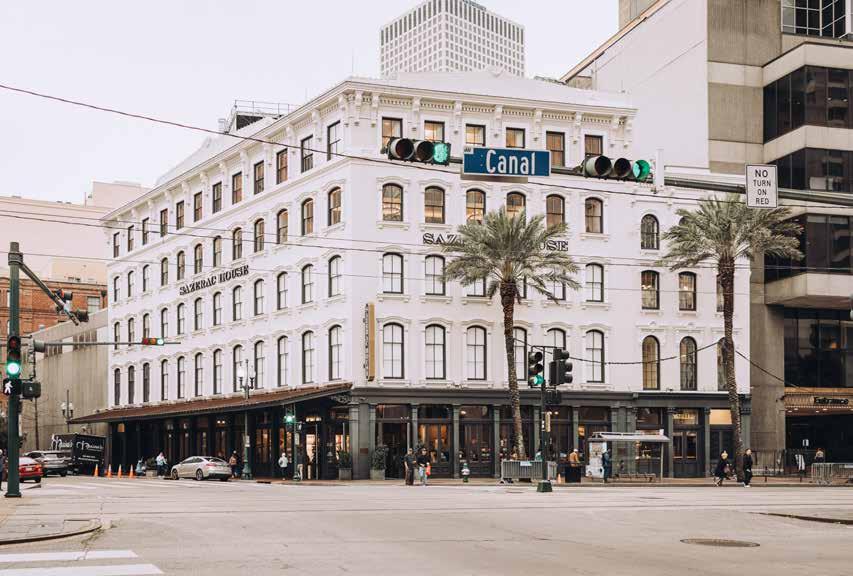
Source: CoStar

Downtown’s innovation economy continued its transition from conceptual branding and visionary planning to operational infrastructure in Q3 2025. The period was marked by increased development activity, expanded institutional partnerships, and the continued emergence of a defined research corridor centered around the BioDistrict.
New permit activity within the BioDistrict formalized a pipeline of new construction, signaling the area is moving from concept to execution. Each approved project further clarifies the district’s vision and framework, linking academic, medical, and privatesector assets with a shared goal of generating high-wage, knowledge-based employment in the Downtown core and along Tulane Avenue in Mid-City.
This past quarter, two major permits were issued for construction, helping to advance the burgeoning

district. First, Xavier-Ochsner College of Medicine received permits to build its forthcoming medical school on the ground floors of Benson Tower on Poydras Street. Valued at $9.2M in construction activity, the project will bring a third medical school to Downtown New Orleans. Among other projects underway at Tulane University’s Downtown Campus, the institution received permits to build a $2.77M in public space improvements. Other permits received by Tulane this quarter include the renovation of 1415 Tulane Avenue to house the Tulane School of Nursing, in addition to building out space for a nonprofit tenant, College Track , at 275 Lasalle Street.
A key development this quarter was the launch of the Tulane Innovation Institute’s Founder Lab to serve as the connector between Tulane’s research enterprise and the regional entrepreneurial market. The program provides pre-seed funding, mentorship, and commercialization support for faculty, students, and alumni, offering a pathway to bring researchbased products to market without leaving the city.
This Downtown-based initiative plays an important role in retaining intellectual capital that has historically migrated to larger urban centers across the country. By embedding this support within the urban core, Tulane’s investment reinforces its institutional commitment to a visible Downtown presence while working to enable a successful research to commercialization pipeline.
DDD remains committed to collaborating with Tulane and others in the innovation ecosystem to ensure that these emerging firms remain connected to the broader Downtown community.
In a significant step forward for international research collaboration, LSU Health New Orleans announced a new partnership with the Indian Institute of Technology Madras (IIT Madras) —India’s highestranked engineering university. This agreement reflects Downtown’s growing role as a hub for globally connected innovation and education. The partnership establishes a framework for joint programs focused on advancing global health through education, research, and technology-driven
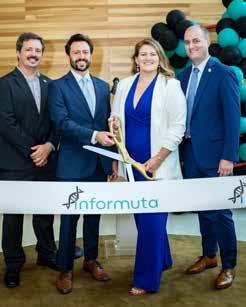
entrepreneurship. Under the newly signed Memorandum of Understanding, LSU Health’s leading clinical and biomedical research in fields such as cancer and genomics will be paired with IIT Madras’ expertise in engineering and digital innovation to develop scalable, technologyenabled healthcare solutions.
Beyond the research collaboration itself, the initiative aims to translate global expertise into measurable improvements in patient care for Louisiana residents and their families. By combining international academic strength with local clinical capacity, the partnership reinforces Louisiana’s health system while positioning Downtown New Orleans as a focal point for translational health innovation in the Gulf South.
DDD looks forward to the continued impact of this collaboration as it takes shape within the heart of the Crescent City, strengthening both the local economy and the state’s role in global medical research.
The quarter also saw a significant milestone in local commercialization with the grand opening for Informuta , a biotechnology firm specializing in diagnostic analytics. The company’s expansion within
As projects within the BioDistrict move from permit approval to occupancy, Downtown New Orleans is positioning itself not just as the region’s commercial center but as the physical and intellectual hub of the Gulf South innovation economy. As momentum continues to grow, DDD looks forward to collaboration with partners to sustain progress on the path from vision to execution.
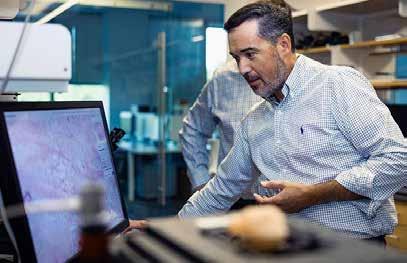
the BioDistrict demonstrates both investor confidence and market readiness for life sciences tenants in the Downtown area. DDD was thrilled to join the New Orleans BioInnovation Center (NOBIC) and partners to cut the ribbon and officially open their new space.
Informuta’s trajectory—from university research to an established biotechnology firm with lab space Downtown— illustrates the strength of New Orleans’ emerging innovation pipeline. Its decision to maintain space in the city despite competing national offers highlights the region’s improving value proposition: competitive operating costs, strong institutional partnerships, and an authentic sense of place. The firm’s presence sets a precedent for how early-stage biotech companies can scale locally, offering a model for future firms to transition from campus-based R&D to commercial operations without geographic displacement.

Total 38,929 34,854 2 554,114 2 Projects | SF Under Construction Entitled
1 627,897 5 Seeking
Downtown’s hospitality sector experienced a recalibration in Q3 2025 as key metrics adjusted following an exceptional 2024 driven by large events and early convention bookings. Hotel demand totaled just over 1.1 million cumulative nights, down 8.5% year-over-year, while supply held steady at roughly 2.17 million room nights. Average occupancy softened to 50.9%, accompanied by modest declines in both average daily rate ($153.60) and revenue per available room ($78.73).
The data suggest a cooling from prior-year peaks rather than a structural downturn, reflecting seasonal normalization and rate competition across peer markets. With several major hospitality redevelopments underway and the potential for an international visitation rebound in 2026, Downtown remains well positioned for renewed growth in the next cycle.
Downtown’s hospitality sector continued its rebound through a blend of investment, event density, and experiential diversification. The Audubon Institute’s riverfront park expansion advanced quickly through design, permitting, and
construction, linking major tourism corridors with open-space access and reinforcing the river as both an economic and ecological resource. Additionally, the Audubon Nature Institute celebrated the grand opening of the newest addition to Woldenberg Riverfront Park, located at 1 Canal Street. The event brought together city leaders, community members, and special guests to unveil a beautifully designed green space that reconnects residents and visitors with the Mississippi River and enhances the overall Downtown experience.
The project introduces expanded shaded areas, lush landscaping, and improved pedestrian connectivity that align with ongoing beautification efforts along Canal Street and the broader Downtown Riverfront park system. Completed through funding from the City of New Orleans Capital Outlay and Audubon’s general fund, this development is part of a longterm vision to make New Orleans’ Riverfront one of the most dynamic and accessible in the nation. DDD commends the Audubon Nature Institute for its leadership and investment in this transformative project and looks forward to continued progress at the foot of Canal Street and along the Riverfront, where public and private initiatives are together shaping a more vibrant, connected Downtown environment.
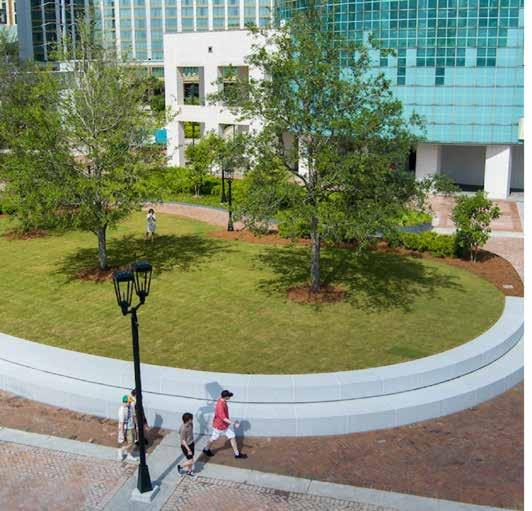
544 399 5 173 4 Projects | Rooms Under Construction Entitled
7
16 Seeking Entitlement
Total
1,116
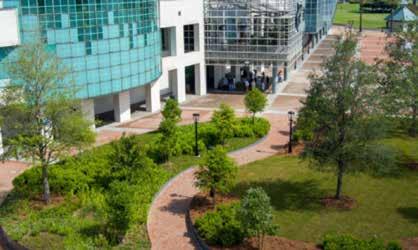

Simultaneously, the New Orleans Culinary & Hospitality Institute (NOCHI) Spring 2025 cohort graduated into a tight labor market, supplying hotels and restaurants with a trained workforce as newer properties like the Four Seasons and Kimpton continue to strengthen the city’s culinary reputation. As an anchor institution for both Downtown New Orleans and the broader hospitality industry, NOCHI not only helps meet the demand for skilled professionals but also reinforces New Orleans’ identity as a world-class dining and hospitality destination. Moreover, its graduates contribute directly to the vibrancy of the Downtown dining and entertainment scene upon graduation.
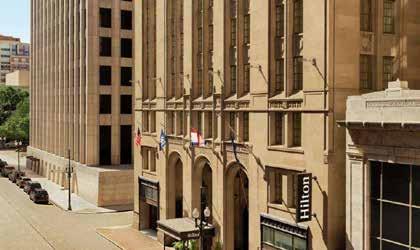

Private capital sustained momentum through HRI Properties’ acquisition of the Hilton New Orleans St. Charles Avenue, signaling investor confidence from a locally headquartered developer known for transformative renovations. That confidence echoed through the global stage when Tales of the Cocktail 2025 drew record attendance, reaffirming New Orleans as the birthplace and ongoing capital of cocktail culture. The return of NOLA Pickle Fest further diversified Downtown’s event calendar, pulling visitation during a shoulder month and demonstrating the district’s capacity to host both lifestyle and professional audiences. Together these threads tell a story of convergence—local workforce development, national investment, and international visitation reinforcing each other to create durable hospitality demand.
Downtown New Orleans’ multifamily market demonstrated continued stability and resilience through the third quarter of 2025. Total inventory remained consistent at 6,370 units, while overall vacancy inched upward to 7.8% —a modest change that reflects steady turnover and new lease activity within a balanced environment.
Average rent held firm at $2,012 per month, signaling enduring tenant demand despite softening in many national peer markets. The sector’s ability to maintain pricing stability through macroeconomic fluctuations highlights Downtown’s sustained appeal as a residential location defined by walkability, culture, and proximity to employment.
Within the for-sale segment, the average unit price was recorded at $177,000, representing an 8.8% decline from the previous quarter. While this adjustment reflects broader national cooling in condominium pricing, local absorption improved modestly, indicating that buyer interest remains healthy at more accessible price points. Together, these factors suggest a market in equilibrium —with manageable vacancy, steady
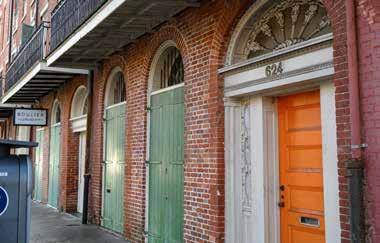
leasing velocity, and population retention supporting consistent long-term fundamentals. Downtown’s housing mix continues to benefit from a diverse resident profile that spans professionals, students, and retirees drawn to the district’s convenience and cultural amenities. This diversity contributes to market durability, reducing exposure to any single economic sector and ensuring ongoing demand across multiple income brackets.
At the federal level, legislative progress in Q3 advanced several key financing tools central to Downtown’s housing strategy. Movement toward making the New Markets Tax Credit (NMTC) permanent signaled a strengthening environment for urban reinvestment and adaptive reuse. For Downtown developers, the NMTC’s permanency enhances long-term project planning and investor confidence, particularly for complex, mixed-use rehabilitation project. The continued ability to layer NMTC, Low-Income Housing Tax Credits (LIHTC), and state and federal historic rehabilitation credits remains essential to Downtown’s redevelopment model. These tools enable financially viable conversions of underutilized commercial buildings into housing, while preserving the architectural and historic integrity that defines the District’s urban fabric.
DDD continues to advocate for the preservation and expansion of these programs as core mechanisms for equitable housing production. Predictable and accessible financing conditions are vital for maintaining the pace of adaptive reuse projects and supporting a balanced mix of market-rate and affordable housing options within the urban core.
At the state level, stable policy frameworks around historic preservation and tax credit allocation further reinforce Downtown’s position as an epicenter of high-quality urban redevelopment projects.
Market performance throughout the quarter reflected steady consumer interest across a range of price points and property types. On the upper end, a condominium at 625 St. Charles Avenue sold for $1.5 million, underscoring persistent demand for high-end, amenityrich housing in walkable urban environments. This segment continues to attract both local professionals and out-of-state buyers seeking investment opportunities in a historically rich setting with strong rental potential.
At the neighborhood scale, community reinvestment continued to shape Downtown’s residential identity. The reopening of Moto Julia under local ownership added new momentum to the area’s live-work dynamic, reinforcing Downtown’s identity as a place
Taken together, Q3 developments portray a multifamily ecosystem defined by interdependence: federal incentives enabling redevelopment, private investment generating housing diversity, and local ownership reinforcing cultural continuity. While national housing markets continue to experience volatility linked to interest rate shifts and rising construction costs, Downtown New Orleans has maintained a pattern of steady performance rooted in adaptive reuse, mixed-income diversity, and proximity to employment and amenities. The district’s compact scale and walkable character continue to serve as competitive advantages,
where residential density and small business activity intersect. The addition of locally owned retail and service businesses contributes to a more vibrant street-level experience, an essential factor in retaining residents and attracting new tenants to the core.
These localized investments complement larger-scale developments and contribute to the district’s overall sense of vitality. The ability to sustain both high-end investment and grassroots reinvestment reflects Downtown’s economic balance and community growth.


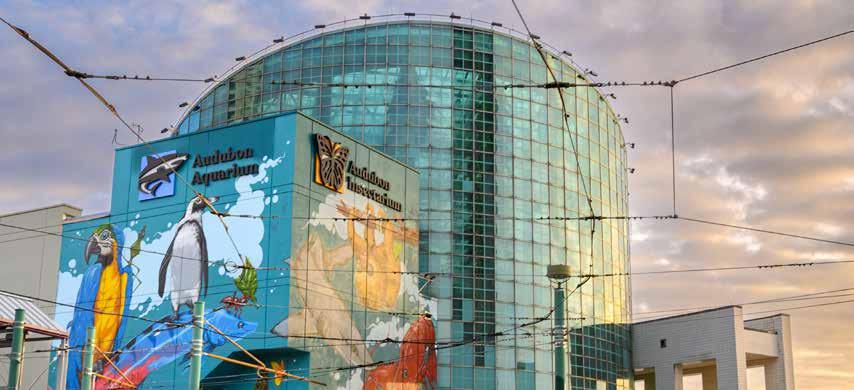
particularly for younger renters and professionals seeking an urban lifestyle at a manageable cost. As developers continue to leverage tax credit programs and investors seek predictable returns in resilient urban submarkets, Downtown New Orleans is positioned to extend its reputation as a model of unique redevelopment projects that support housing growth in the Gulf South. DDD will continue to monitor performance indicators closely, advocating for policies that align housing affordability with economic opportunity. The district’s ability to integrate historic preservation, amenity access, and investment-grade development will remain central to its long-term success as a vibrant residential community.
Downtown New Orleans’ office market demonstrated continued stability in the third quarter of 2025, reinforcing the district’s reputation as a steady performer in a period of national uncertainty. Total inventory held firm at 16.7 million square feet , with Class A supply steady at 9.4 million square feet . Overall vacancy edged down to 12.1%, while Class A vacancy improved to 19.0%, marking the third consecutive quarter of incremental progress.
Average asking rents experienced a modest 0.7% correction as landlords prioritized occupancy and renewals over short-term rate escalation. This measured approach reflects a market in equilibrium—disciplined in pricing, resilient in absorption, and increasingly supported by a base of smaller, diversified tenants that value Downtown’s accessibility, cultural vibrancy, and cost advantage over regional competitors.
As national office markets continue to adjust to shifting workplace norms, Downtown New Orleans’ performance underscores the advantages of a right-sized, diversified market. The district’s mix of professional services, education, technology, and civic tenants continues to provide balance and adaptability through economic cycles.

Downtown’s momentum has long been supported by activity among software-as-a-service (SaaS) and innovation-oriented firms, many of which are drawn by Downtown’s affordability and connectivity to the city’s higher-education and tech ecosystem. These tenants typically occupy spaces under 15,000 square feet, favoring collaborative, flexible layouts suited to agile business models.
A recent update to the New Orleans SaaS Map, published by Johnny Page, CEO of SaaS Academy,
highlights Downtown’s concentration of technology firms—reinforcing the district’s role as a regional hub for digital innovation and entrepreneurship.
Notable Downtown firms include:
• The Idea Village, a nationally recognized accelerator and Forbes “#1 Biggest Brain Magnet,” positioning New Orleans among the top 10% of U.S. cities to launch a business.
• iSeatz, a global leader in digital commerce and loyalty platforms for major travel brands.
• HitPath, a performance marketing platform offering privacy-first, cookieless attribution analytics.
• NOLA AI, a local startup advancing artificial intelligence through contextual and theory-of-mind frameworks.
Together, these firms represent the growing depth of Downtown’s SaaS ecosystem—from earlystage startups to globally scaled enterprises. Their continued investment underscores the district’s reputation as a launchpad for scalable, tech-driven companies. With access to local accelerators, academic talent, and venture networks, Downtown New Orleans is becoming synonymous with software success.

Support from Louisiana Economic Development (LED) continues to strengthen Downtown’s competitiveness as a location for digital media, research, and technology investment. State-level incentive programs have become key tools for business attraction and retention, allowing firms to expand while maintaining Downtown headquarters. LED’s Digital Interactive Media and Software Program remains one of the most competitive in the country, offering a 25% tax credit on qualified resident labor and 18% on production expenditures. These benefits make Downtown a strategic choice for software developers and digital media companies seeking sustainable growth.
The High Impact Jobs Program, introduced in 2025, adds further support by offering reimbursable grants for up to five years
to companies that create new jobs paying at or above the parish average. Open to businesses of all sizes—including those creating a single new position—the program encourages incremental, sustainable job growth across multiple industries.
Additionally, the Research and Development Tax Credit provides a 30% credit on qualified R&D expenditures for companies investing in innovation within Louisiana, with no minimum spend requirement. These incentives, together with Downtown’s infrastructure and accessibility, are helping shape a diverse pipeline of technology and bioscience users that complement the district’s established professional base.
For details on eligibility and applications, the Louisiana Wins Business Incentives Guide offers a comprehensive overview of these and other LED initiatives. Together, these programs reinforce Downtown New Orleans as a hub for high-growth sectors and long-term employment in the Gulf South.
The quarter also marked the expansion of Lee & Associates, North America’s largest broker-owned
commercial real estate firm, into the Downtown market. The firm opened its New Orleans office at 601 Poydras Street in the Pan American Life Center, extending its Gulf South footprint following successful launches in Baton Rouge and Lafayette.
“Our leadership from Baton Rouge and Lafayette has been outstanding,” said Lee & Associates CEO Jeffrey Rinkov. “Building a market-leading, multidisciplined presence in New Orleans allows us to better serve clients across the I-10 Corridor.”
Lee & Associates’ arrival enhances Downtown’s connectivity to national investors and tenants, strengthening cross-market deal flow and reinforcing external confidence in the district’s leasing potential. DDD welcomes this expansion and looks forward to the firm’s continued role in advancing market and investment activity.
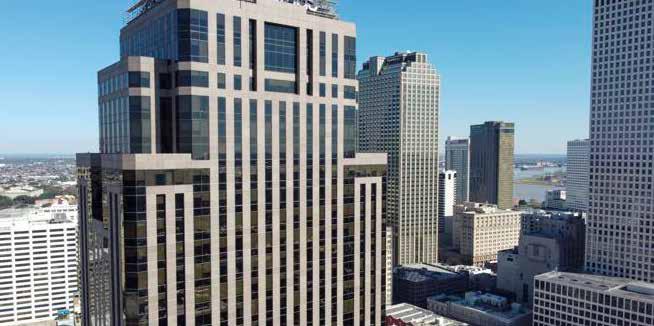
As major U.S. office markets face persistent vacancy and contraction, Downtown New Orleans stands out for its diversification rather than density. The district continues to absorb innovation firms, creative agencies, and professional services tenants at a scale aligned with its ecosystem and workforce.
This evolving balance reflects a quiet but enduring recovery—one driven not by speculative construction but by adaptive reuse, right-sizing, and intentional clustering around education, culture, and technology. The result is a stable, self-correcting office market positioned for long-term growth and resilience rather than short-lived expansion.

Mobility improvements across the third quarter of 2025 underscored Downtown New Orleans’ continued commitment to accessibility, connectivity, and equitable transportation. The City’s forthcoming e-bike initiative —supported by new rebates and an expanded docking network—represents the next phase of multimodal investment designed to improve first- and last-mile connections between residential neighborhoods, hospitality corridors, and major employment centers such as Downtown.
This expansion will make micromobility a more practical and predictable transportation choice for everyday commuters. By encouraging e-bike use for short-distance trips, the program reduces commute friction, alleviates parking demand, and enhances circulation across the urban core. Once fully implemented, the system will complement existing pedestrian and transit infrastructure, supporting Downtown’s ongoing evolution as a district that prioritizes mobility convenience and sustainability.
DDD continues to coordinate with City departments, transportation agencies, and private operators to ensure Downtown remains central to these advancements. By aligning policy with infrastructure, the city is creating a transportation environment that connects opportunity, reduces dependency on automobiles, and reinforces the urban experience as accessible to all users—workers, residents, and visitors alike.
A major regional milestone occurred this quarter with the launch of Amtrak’s Gulf Coast Service, restoring passenger rail service between New Orleans and Mobile for the first time since
Hurricane Katrina. The long-anticipated return of this route reconnects New Orleans to the broader eastern Gulf region, expanding environmentally sustainable and cost-effective travel options.
Early ridership reports indicate strong weekend and event-driven demand, particularly from leisure travelers seeking convenient access to New Orleans’ cultural and entertainment offerings. This trend reinforces Downtown’s position as the Gulf Coast’s primary destination hub —a gateway for regional tourism, business travel, and cross-market collaboration.
Beyond its tourism benefits, the reinstated Gulf Coast Service represents a significant step toward long-term regional integration. Improved passenger rail access supports economic mobility, broadens labor market reach, and creates new opportunities for investment along the corridor. For Downtown, the service strengthens its intercity linkages and underscores its role as the region’s multimodal anchor—home to Amtrak, RTA, and regional transit operations. DDD and its partners will continue to monitor the service’s performance and advocate for enhanced connectivity, including future extensions and improved connections to local transit. Together, these investments demonstrate how coordinated transportation planning can elevate Downtown’s competitiveness and reinforce its regional leadership.
At the city level, the Office of Nighttime Economy introduced a practical solution to one of Downtown’s longstanding mobility challenges: parking access
for hospitality and service-sector employees. The new parking pilot program, offering discounted garage parking for restaurant, hotel, and entertainment workers, directly addresses barriers to workforce participation and safety.
This initiative improves both affordability and security for essential workers who sustain Downtown’s hospitality and entertainment economy. By reducing transportation costs and providing predictable access to parking near employment centers, the program helps stabilize staffing levels while promoting equitable access to nighttime employment opportunities.
The pilot also represents a model for how mobility planning can be worker-centered, integrating transportation policy with economic inclusion goals. As the program evolves, feedback from participating employees and employers will help refine its structure, ensuring it remains responsive to workforce needs while complementing Downtown’s broader parking management and mobility strategies. Together, these efforts demonstrate the city’s recognition that a thriving nighttime economy depends on reliable, safe, and affordable access for the workers who support it.
Taken together, these developments—micromobility expansion, regional rail restoration, and workforce-focused parking initiatives—illustrate a comprehensive approach to urban movement grounded in access and sustainability.
Downtown’s transportation ecosystem is increasingly defined by integration rather than isolation: e-bikes connecting to transit stops, regional trains feeding pedestrian networks, and worker mobility programs aligning with local business needs. This interconnected framework allows residents and commuters to move efficiently between neighborhoods, employment centers, and regional destinations while reducing congestion and environmental impact.
From a policy standpoint, these mobility advancements reinforce Downtown’s long-term economic strategy. Improved transportation access supports workforce retention, enhances visitor experience, and strengthens the district’s competitiveness for new investment. As more employers and residents seek neighborhoods where movement is convenient and reliable, Downtown New Orleans continues to position itself as a model for walkable, multimodal urban design in the Gulf South.
DDD remains a key partner in advancing these priorities, working with City agencies, regional transit authorities, and private-sector partners to align infrastructure improvements with the district’s economic development goals. Q3 2025 demonstrated meaningful progress toward a transportation system that not only moves people efficiently but also connects them to opportunity— making Downtown New Orleans more accessible, equitable, and sustainable than ever before.

Retail / Hotel / Office 1010 Common Renovation Kailas Companies
Residential The Gravier Apartments Koobehi Properties LLC
Retail / Residential 955 Howard Ave Vinson Properties#1 LLC
Retail / Residential 941 Julia Street Renovation Hadrian Properties LLC
Retail / Office Bienville Club Gootee Construction
Hotel 210 St Charles Ave The McDonnel Group, L.L.C.
Hotel 1000 Howard Ave Hotel 1000 Howard Ave Hotel
Hotel 333 N Diamond St Hotel ERG Enterprises
Office/ Hotel 807 Howard Ave Tipsy Clover LLC
Retail / Residential 827 Carondelet St 827 Carondelet LLC
Hotel Hotel Santa Maria Diamond Street Ventures LLC
Institutional Tulane Nursing Program Tulane University
Institutional College Track Tulane University
Retail/ Residential/ Office/ Hotel Charity Hospital 1532 Tulane Partners Inc
Institutional Xavier-Ochsner College of Medicine Xavier University
Hotel / Retail 717 Common 717 Common Properties, LLC
Hotel/ Retail 934 Canal St 1015 Canal LLC/934 Canal LLC
Residential 814 Howard Residential G O A T
Hotel 300 Magazine Hotel Khoobehi Properties
Residential Lucky Dog Residential Lucky Dogs Airbnb, LLC
Institutional WWII Museum Expansion WWII Museum
Hotel Gus Mayer Hotel AQ Studios
Hotel 635 S Peters St 635 S Peters St
Hotel/ Retail NOLA AC Hotel Nola Lodging Group LLC
Hotel 923 Julia Hotel Metro Studio
Hotel 843 Camp Hotel 843 Camp St Development LLC
Hotel 749 Saint Charles Ave 749 St Charles Ave LLC
Retail Ombra Wine Bar Nicole Paraggio & Gregory Carr
Hotel / Retail 615 Baronne Hotel AQ Studios



Downtown Development District of the City of New Orleans 201 St. Charles Ave, Ste 3912 New Orleans, LA 70170 | 504.561.8927
Created by the Louisiana Legislature in 1974 (LA Rev Stat § 33:2740.3) as the nation’s first assessmentbased Business Improvement District, the Downtown Development District of the City of New Orleans (DDD) provides enhanced economic development and public space services to Downtown New Orleans. It accomplishes its mission through initiatives such as employing dedicated city planners to assist Downtown property and business owners, administering multiple grant programs, employing Public Safety Rangers and Clean Team sanitation workers, providing significant funding for outreach to the homeless and additional New Orleans Police Department patrols and armed private security throughout the District. The DDD services the area bounded by Iberville Street, the Pontchartrain Expressway, Claiborne Avenue, and the Mississippi River.
DDD is funded by a property tax millage assessed on each non-exempt property within the District. DDD’s lifespan was initially ten years, and on December 8, 1979, a successful citywide referendum secured longevity for DDD. It authorized DDD to raise its property tax rate to as much as 22.9 mills (a privilege the DDD has never exercised); it gave DDD the authority to sell up to $7.5 million in bonds for use in capital improvement projects; it extended DDD’s lifespan for an additional 25 years to December 31, 2005; and it provided for a future election in which voters could extend DDD for an additional 25 years beyond 2005. An election was held on April 7, 2001, with 60% voting in favor, and DDD’s lifespan was extended through 2030.